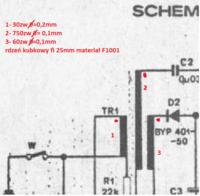Hello! I need to build an electric shepherd dog that notoriously jumps the fence  .
.
I would like to ask you for help in building something like this on the simplest possible elements. One of my requirements is that it should run on a 12v (car) battery.
From what I have already read and understood, some elements will already be at home. Like for example (high voltage coil from the car, capacitors, etc.) But unfortunately I do not know anything about the module (which was most often called 555). Can it be replaced with another one that I find in a power supply?
Sorry for my little knowledge as an electronics engineer. If someone could explain it to me in a simple way, I would be grateful.
Regards Kacper.
I would like to ask you for help in building something like this on the simplest possible elements. One of my requirements is that it should run on a 12v (car) battery.
From what I have already read and understood, some elements will already be at home. Like for example (high voltage coil from the car, capacitors, etc.) But unfortunately I do not know anything about the module (which was most often called 555). Can it be replaced with another one that I find in a power supply?
Sorry for my little knowledge as an electronics engineer. If someone could explain it to me in a simple way, I would be grateful.
Regards Kacper.







